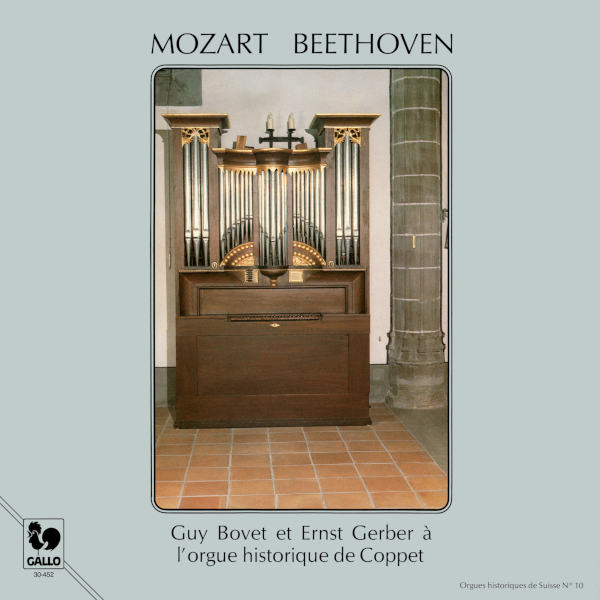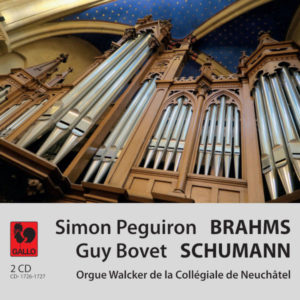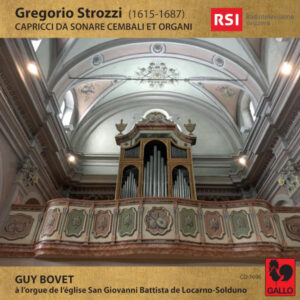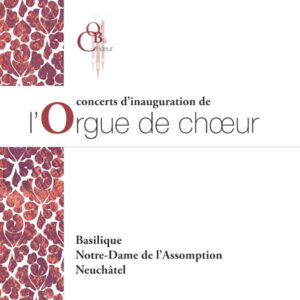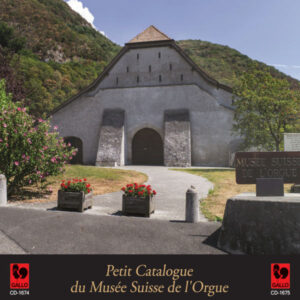Extraits / Excerpts
Mozart: Fantasy in F Minor, K. 608 - Beethoven: Fugue in D Major, WoO 31 - Œuvres pour Orgue - Guy Bovet, Ernst Gerber, Claude Maréchaux
Wolfgang Amadeus MOZART: Fantasy in F Minor, K. 608 – Adagio and Allegro in F Minor, K. 594 – Andante in F Major, K. 616 – Andante in B-Flat Major, K. 15ii – Allegro in G Minor, K. 15r – Ludwig van BEETHOVEN: Fugue in D Major, WoO 31 – 3 Pieces for Mechanical Organ, WoO 33a: II. Scherzo. Allegro – 3 Pieces for Mechanical Organ, WoO 33a: I. Adagio.
Guy Bovet and Ernst Gerber at the historic Organ of Coppet.
Works for Small Organ
The pieces on this recording are seldom to be heard: Mozart and Beethoven certainly have not built their reputation on organ pieces. However, in search for a repertoire suitable for the organ of Coppet, it was tempting to record these pieces, all composed more or less at the time when the instrument was built. In fact, playing for example the two large pieces by Mozart on a small instrument has solved some problems always experienced by organists attempting a performance on a large organ.
Obviously (and although Mozart complained about it in a letter to his wife written in 1790), the mechanical organs for which he composed this music were rather modest in size, and Mozart, whether he liked it or not, has adapted himself to the medium. It is a joy to see how well the fast tempo required for the dotted parts of Fantasy in F Minor, K. 608 works: on a large organ, one has to play these sections too slowly, and to find another, faster tempo for the Fugues.
Also, a large pleno is too heavy for the music, but on the other hand, it is frustrating to play these sections on a few stops only. This music is really written for a Tutti on a small instrument.
Many of these pieces have been commissioned by a count Deym who was running a «Kunstkabinett» in Vienna, a kind of Wax Museum with statues and automatic musical instruments, providing background music to go with the exhibition. Since the music was played by machines, it is hard to perform for one player only, and soon after Mozart’s death, these pieces were so famous that they were published in two versions for four hands.
This solution makes it possible to play all the notes, all the trills, etc., and thus to achieve a result as close as possible to the original version. We have similarly arranged the pieces by Beethoven (except for the Fugue) from the manuscript notated on four staves. They were commissioned by the same count Deym.
Fantasy in F Minor, K. 608
A large fresco in seven parts — introduction in dotted style, fugue, dotted interlude, andante with variations, dotted interlude, second fugue on the same subject, dotted finale with fugal stretto — composed extremely carefully. The counterpoint in the Fugues is admirable and uses all the subtleties of the profession; the Variations in the central part are expressive but kept in a strict shape interrupted only at the end by a Cadenza; the French-inspired dotted sections include some very bold modulations. One could say that this work is a «total» work: all the art of the composer appears in it.
Adagio, Allegro (and Adagio) KV 594
In Deym’s «Kunstkabinett» a life-size statue of the famous Feldmarschall Laudon was featured in a glass coffin, with artificial light, and Mozart was asked to compose a «Trauermusik» (funeral music) to be played in the room where the mausoleum was displayed. The central part certainly reminds of the Feldmarschall’s military achievements, with fanfares, whereas the two corner parts are in a sad, expressive atmosphere.
Andante KV 616
This piece was played for another scene in the Kunstkabinett, called «The Graces bedtime», showing a bedroom lit by alabaster lamps and a beauty going to bed: the music is charming but certainly does not put anyone to sleep!
Andante cantabile KV 15ii
Comes from the «London sketchbook», filled by eight-years-old Mozart in 1764/65.
Allegro KV 15r
Comes from the same source. These pieces are probably not really for organ; however, they have been written at the time when young Mozart had great success as an organist in Versailles and London. One admires the harmonic variety and virtuosity of this Allegro, which reminds of Domenico Scarlatti who also liked to quote hunting horn calls as we find at the end of each part of this short piece.
Fugue in D (Beethoven)
Composed in Bonn at the age of 13, for a job competition. It is a very simple two-part fugato, with a few additional voices at the end.
Scherzo in G (Beethoven)
Another commission of Count Deym. This piece was composed in 1799, very much in the style of Haydn’s clockwork organ pieces.
Adagio in F (Beethoven)
Part of the same set, but the style is much more personal. The arrangement for organ solo is also much more problematic: the original, notated on 4 staves, cannot be played on one manual only, even by two players, because the voices overlap all the time.
The ideal way to play this Adagio would perhaps be with two players on two manuals. In order to make a performance on the Coppet organ possible, we had to simplify many passages. On one side, it is a pity; on the other, the music is still very beautiful and we wanted very much to have this piece on this recording: it is a most valuable addition to such a set of rare music.
- Categories
- Composers
- Interprets
- Booklet
